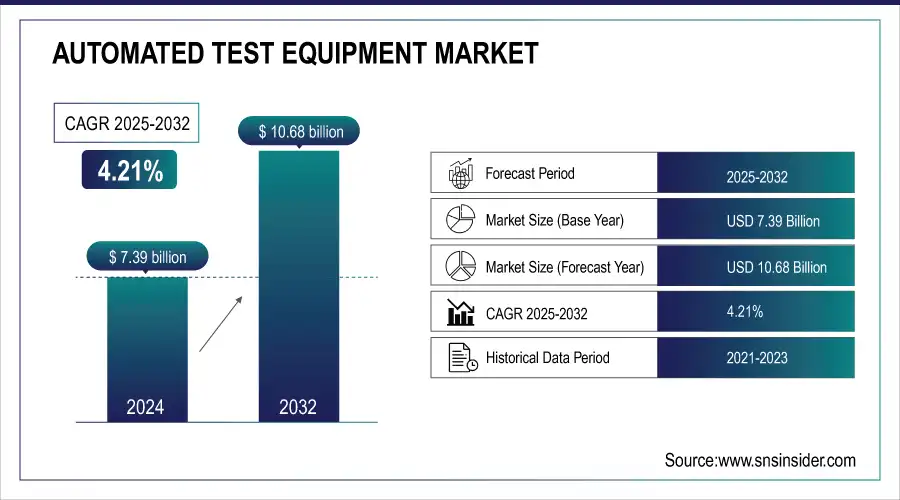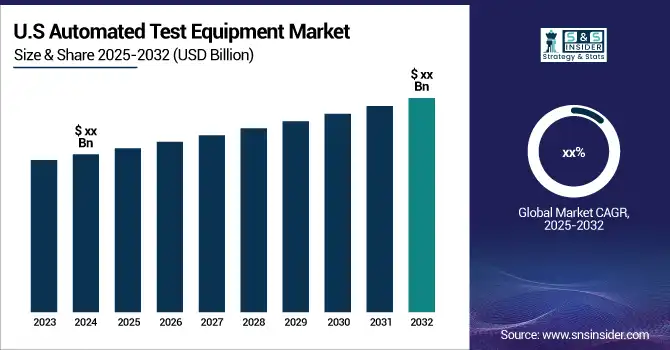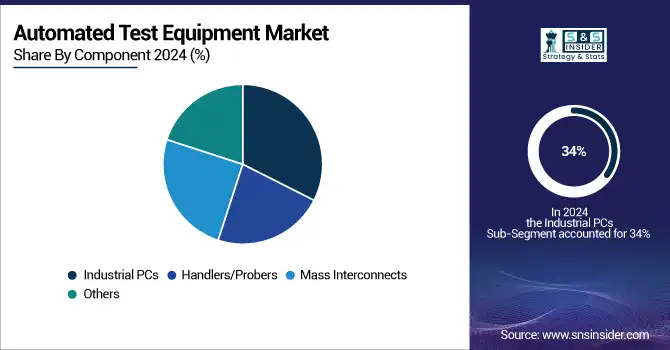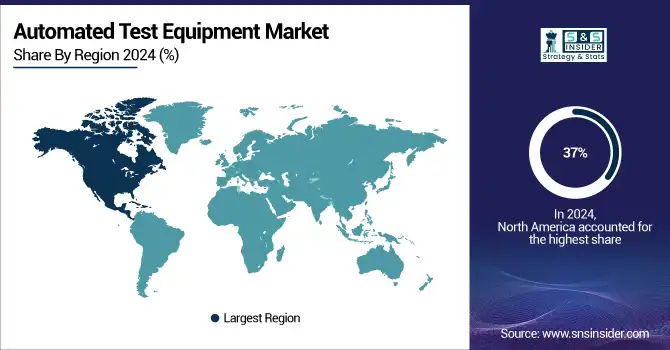Automated Test Equipment Market Report Scope & Overview:
The Automated Test Equipment Market size was valued at USD 7.39 Billion in 2023, It is estimated to reach USD 10.68 Billion by 2032, growing at a CAGR of 4.21% during 2024-2032.
ATE systems are used to automate the testing process for semiconductor devices, printed circuit boards (PCBs), and other electronic components, providing a more efficient and accurate alternative to manual testing. As the complexity of electronic devices continues to increase, the demand for ATE has grown significantly, making it a pivotal market in the technology sector. The market for ATE is also being driven by the growing demand for consumer electronics, such as smartphones, tablets, and wearables.

Get more information on Automated Test Equipment Market - Request Sample Report
With the rollout of 5G networks and the increasing complexity of communication devices, there is a growing need for efficient and accurate testing solutions. The subscriber base for 5G in the U.S. has also expanded rapidly, with around 100 million users in 2023. This number is expected to more than double by 2025, potentially covering nearly 60% of the country's total mobile subscriptions. In terms of network deployment, U.S. carriers have made substantial progress. By mid-2023, 5G networks covered about 85% of the U.S. population, particularly in major urban areas. ATE systems are used to test the performance of communication devices and network infrastructure, ensuring they meet the stringent requirements of modern telecommunications. This has led to increased demand for ATE in the telecommunications sector, as companies strive to deliver reliable and high-performance products.

Market Size and Forecast:
-
Market Size in 2024: USD 7.69 Billion
-
Market Size by 2032: USD 10.68 Billion
-
CAGR: 4.18% from 2025 to 2032
-
Base Year: 2024
-
Forecast Period: 2025–2032
-
Historical Data: 2021–2023
Key Automated Test Equipment Market Trends
-
The semiconductor industry is driving strong demand for ATE as the complexity of integrated circuits (ICs) and system-on-chip (SoC) designs continues to rise.
-
The rapid adoption of 5G technology and IoT devices is fueling the need for advanced and high-speed testing solutions.
-
Automotive electronics, particularly in electric vehicles (EVs) and ADAS systems, are becoming a major growth driver for ATE deployment.
-
The shift toward system-on-chip and high-performance computing is creating demand for specialized testing equipment.
-
Integration of AI, machine learning, and analytics is enhancing efficiency and accuracy in automated testing processes.
-
Increasing demand for wireless and RF testing is emerging due to the surge in connected and smart devices.
Automated Test Equipment Market Growth Drivers
-
Rising Demand for Advanced ATE Systems Driven by 5G and Next-Gen Wireless Technologies.
The increasing need for ATE systems is being fueled by the continuous progress in wireless communication technologies such as 5G, Wi-Fi 6, and beyond. These technologies are essential for contemporary communication systems, facilitating quicker data transfer, reduced delays, and enhanced connectivity. The introduction of 5G networks is anticipated to bring about significant changes in multiple sectors like telecommunications, automotive, healthcare, and manufacturing by allowing for innovations such as autonomous vehicles, smart cities, and industrial IoT. Testing the semiconductor components and communication modules powering these technologies necessitates advanced ATE systems that can manage high frequencies, wide bandwidths, and complex modulation schemes linked to 5G and other advanced wireless technologies. ATE systems need to test how multiple communication standards work together in one device to ensure compatibility and functionality on various networks. The demand for ATE systems will remain high due to the shift to 5G and the continuous advancement of next-gen wireless technologies, as manufacturers aim to guarantee the efficiency, dependability, and adherence of their communication devices and components.
Automated Test Equipment Market Restraints
-
Impact of Price Pressure on Innovation and Competitive Dynamics in the Automated Test Equipment Market.
The Automated Test Equipment industry is fiercely competitive, as numerous established companies compete for a slice of the market. This competitive market may result in a focus on prices, especially in price-conscious sectors like consumer electronics. Businesses in these industries frequently function with narrow profit margins, so any rise in testing expenses can affect their overall bottom line. Consequently, manufacturers of ATE may experience the need to lower the costs of their systems to stay competitive. The ability to invest in research and development and innovation may be impacted by this pressure on prices, which could potentially result in a delay in developing new and advanced ATE systems. In addition, clients might opt for cheaper testing options like hiring third-party testers or utilizing internal testing techniques, which could reduce the need for ATE systems.
Automated Test Equipment Market Segment Analysis
By Component
Industrial PCs dominated the market in 2024 with a market share of over 34%, as they play a crucial role in controlling and automating testing processes, making them the dominant segment in the Automated Test Equipment (ATE) market. These computers are strong, dependable, and able to function in tough industrial conditions, essential for challenging testing duties in industries like semiconductors, automotive, and aerospace. The widespread adoption of industrial PCs is driven by their ability to handle a variety of testing applications due to their high performance, flexibility, and scalability.
The handlers/probers segment is accounted to have a faster growth rate during the forecast period, due to the semiconductor industry's rising need for accurate and effective testing solutions. With the increasing complexity of semiconductor devices, there is a rising demand for sophisticated probing systems that are capable of accommodating the intricate testing needs of small and delicate components. Handlers/Probers help with the automatic placement, alignment, and removal of devices being tested (DUT), ensuring precise and reliable measurements with minimal human involvement.

By Product
Non-memory ATE held a major market share of over 55% in 2024, primarily because of its wide usage in testing logic devices, analog components, and mixed-signal semiconductors. This part caters to sectors like telecommunications, consumer electronics, automotive, and industrial, all of which depend extensively on complex integrated circuits that need thorough testing. The growth of Non-Memory ATE is fueled by the rising need for high-performance and high-density semiconductors, with manufacturers aiming to maintain quality and reliability in their products.
The memory ATE segment is to experience a rapid growth rate during 2024, due to the increasing demand for memory devices in a wide range of applications including smartphones, data centers, and consumer electronics. The substantial growth of cloud computing, artificial intelligence, and IoT has greatly elevated the demand for memory components like DRAM and NAND flash, necessitating thorough testing to adhere to performance requirements.
Automated Test Equipment Market Regional Analysis
North America Automated Test Equipment Market Insights
North America led the market in 2024 with a major market share of 37%. This dominance is driven by the region's advanced technological infrastructure, high investment in research and development, and a strong presence of leading ATE manufacturers. The U.S. aerospace, defense, and telecommunications sectors are significant contributors to the demand for ATE, as these industries require precise and reliable testing solutions to ensure product quality and performance. Additionally, the rapid adoption of emerging technologies such as 5G and the Internet of Things (IoT) has fueled the need for sophisticated testing solutions.

Need any customization research on Automated Test Equipment Market - Enquiry Now
Asia Pacific Automated Test Equipment Market Insights
The Asia-Pacific region is the fastest-growing region during 2025-2032. This growth is largely attributed to the rapid industrialization and technological advancements in countries such as China, India, and South Korea. The region is experiencing a surge in demand for electronic devices, automotive components, and communication technologies, which drives the need for efficient and advanced ATE solutions. China's robust manufacturing sector and increasing investments in semiconductor and electronics industries are key factors contributing to this growth. Additionally, the expansion of 5G networks and the rise of smart devices in the region are further accelerating the demand for ATE.
Europe Automated Test Equipment (ATE) Market Insights
Europe represents a significant market for automated test equipment in 2024, driven by the robust semiconductor, automotive, and telecommunications industries. The region’s strong adoption of electric vehicles (EVs), coupled with the expansion of 5G networks, is creating substantial demand for advanced semiconductor testing solutions. Leading companies in Germany, France, and the U.K. are investing in next-generation ATE systems to support the development of high-performance computing and artificial intelligence (AI) chips. Additionally, stringent EU regulations regarding product reliability and safety continue to accelerate the use of sophisticated test systems across industries.
Latin America (LATAM) Automated Test Equipment (ATE) Market Insights
The LATAM automated test equipment market is gradually expanding, supported by growing investments in consumer electronics manufacturing, telecommunication infrastructure, and industrial automation. Countries such as Brazil and Mexico are emerging as key contributors due to their electronics assembly and automotive industries. The rising penetration of smartphones and IoT devices across the region has fueled demand for semiconductor components, driving the need for efficient and cost-effective testing solutions. Moreover, multinational companies are increasingly partnering with local manufacturers to enhance testing capabilities and meet international quality standards.
Middle East & Africa (MEA) Automated Test Equipment (ATE) Market Insights
The MEA market for automated test equipment remains at a developing stage but is showing strong potential due to increasing government investments in digital infrastructure, smart cities, and advanced telecommunications. The adoption of 5G technology across countries such as the UAE and Saudi Arabia is creating new opportunities for semiconductor testing and validation. Additionally, the region’s growing automotive and renewable energy sectors are beginning to integrate ATE solutions for battery testing, power electronics, and control systems. International ATE providers are also targeting MEA as a strategic growth region by forming collaborations with local technology players.
Automated Test Equipment Market Competitive Landscape
Teradyne
Teradyne is a global leader in automated test equipment solutions, specializing in semiconductor and system testing technologies.
-
In March 2023, Teradyne launched the UltraFLEXplus, an enhanced version of its UltraFLEX test system, offering higher throughput and improved test capabilities for complex semiconductor devices, particularly targeting next-generation mobile processors and AI chips.
Advantest
Advantest is a Japan-based company recognized for its advanced semiconductor testing platforms and innovative ATE solutions.
-
In June 2023, Advantest introduced the T2000 AiR (Artificial Intelligence & Real-time) platform, designed for AI, 5G, and semiconductor testing, integrating advanced real-time AI analysis to enable faster and more accurate testing.
NI (National Instruments)
NI is a U.S.-based test and measurement solutions provider, focusing on software-connected systems for automated test and data management.
-
In January 2024, NI released an update to its SystemLink Test Management Software, enhancing automation and data analytics with new machine learning algorithms and advanced data visualization tools for improved decision-making in ATE processes.
Automated Test Equipment Market Key Players
- Advantest Corporation
- Cal-Bay Systems, Inc.
- Marvin Instruments Corp.
- Roos Instruments, Inc.
- Shinbashi, Inc.
- Cobham Plc
- Agilent Technologies Inc.
- Teradyne Inc.
- Danaher Corporation
- LTX-Credence
- National Instruments Corp.
- Chroma ATE Inc.
- Astronics Test Systems
- Keysight Technologies
- Yokogawa Electric Corporation
- Anritsu Corporation
- ATE Systems, Inc.
- Texas Instruments (ATE division)
- Seica S.p.A.
- Test Research, Inc. (TRI)
| Report Attributes | Details |
|---|---|
| Market Size in 2024 | US$ 7.69 Billion |
| Market Size by 2032 | US$ 10.68 Billion |
| CAGR | CAGR of 4.18% From 2025 to 2032 |
| Base Year | 2024 |
| Forecast Period | 2025-2032 |
| Historical Data | 2021-2023 |
| Report Scope & Coverage | Market Size, Segments Analysis, Competitive Landscape, Regional Analysis, DROC & SWOT Analysis, Forecast Outlook |
| Key Segments | • By Product (Memory ATE, Discret, Non-Memory ATE, Others) • By Type (Integrated Circuit Testing, Hard Disk Drive Testing, Printed Circuit Board Testing, Others) • By Component (Industrial Pcs, Mass Interconnects, Handlers/Probers, Others) • By Vertical (Automotive & Transportation, IT & Telecommunications, Consumer Electronics, Aerospace & Defense, Healthcare, Others) |
| Regional Analysis/Coverage | North America (US, Canada), Europe (Germany, France, UK, Italy, Spain, Poland, Russsia, Rest of Europe), Asia Pacific (China, India, Japan, South Korea, Australia,ASEAN Countries, Rest of Asia Pacific), Middle East & Africa (UAE, Saudi Arabia, Qatar, Egypt, South Africa, Rest of Middle East & Africa), Latin America (Brazil, Argentina, Mexico, Colombia Rest of Latin America) |
| Company Profiles | Advantest Corporation., Cal-Bay Systems, Inc, Marvin Instruments Corp., Roos Instruments, Inc., Shinbashi, Inc., Cobham Plc, Agilent Technologies Inc, Teradyne Inc, Danaher Corporation, LTX-Credence, National Instruments Corp., Chroma ATE Inc, Astronics Test Systems and other. |

